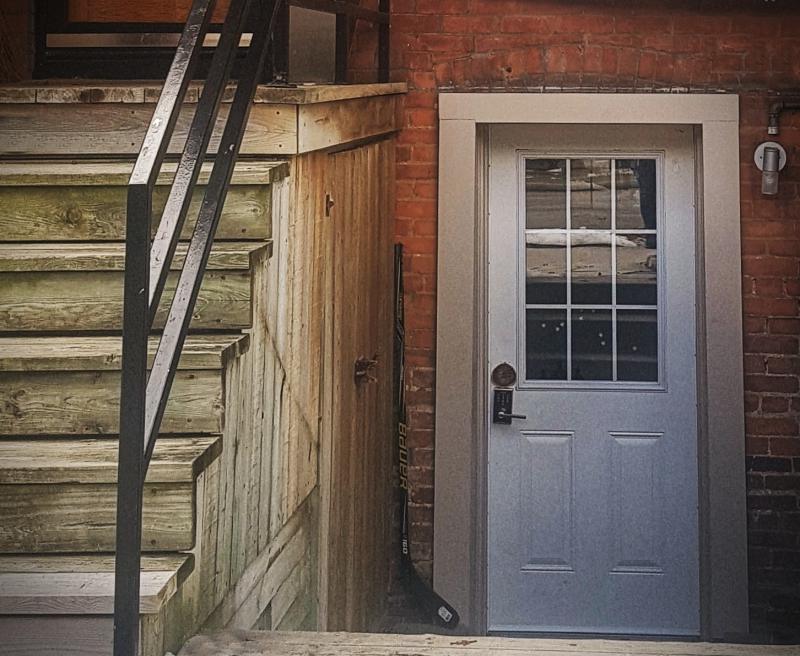Legal Basement Requirements in Toronto
In the City of Toronto, basement apartments are permitted as per the Second Suite Bylaw enacted in 2013. Even though zoning allows a second suite in your property the newly created unit must fully comply fully with all the applicable fire codes, building codes, Electrical Safety Authority regulations and zoning and housing standards by-laws.
The zoning bylaws for basement apartments in Toronto is available here:
[icon icon="icon-new-tab" size="14px"]City of Toronto Zoning By-law 569-2013

The Ontario Building Code which prescribes minimum requirements for the construction of buildings is a code that applies only when the house was built. The building code changes over the time but for the most part, it does not apply retroactively. The fire code which prescribes construction and safety issues as they relate to how the building is required to perform should it catch fire, can apply retroactively.
Basic requirements for creating a legal basement apartment:
- The detached or semi detached house must be at least 5 years old.
- The front of the house cannot be significantly altered to change its appearance from that of a one unit building.
- Basement apartment must be smaller than the main dwelling unit.
- Minimum ceiling height is 6'5". Ceiling must be continuous. Suspended (T-bar type) ceilings and exposed joists are not acceptable. Furnace room ceiling must be dry walled or plastered too.
- Doors must be solid wood or metal and minimum thickness is 1.75". Exterior door must be at least 32"x78". Interior doors must have an 1/2-inch gap at the bottom to provide air movement within the basement apartment, unless return air ducts are installed in the room. The smallest dimension of the window is 18" and the opening must be at least 600 sq in. ?Windows must be within 3' of ground, and if there is window well it must extend 3' from the house wall to allow room to crawl out.
- Bathrooms must have either a window or fan.
- A kitchen equipped with a refrigerator, stove in good repair and working condition. Cupboards having a capacity of not less than four cubic feet multiplied by the total number of persons occupying the unit.
- Newly built basement apartments require building permits before construction begins. In most areas an additional parking space is required for new basement apartments. If there is a parking spot for the upper unit, there must also be a parking spot for the basement apartment.
- The property owner is responsible to make sure that smoke alarms are installed and maintained.
Carbon Monoxide alarms are required under many Municipal By-laws. They are to be provided in each dwelling unit in a building containing a fuel fired appliance or an attached garage. Even if they are not required by legislation they make good sense with to-day's design methods providing for air-tight construction of dwelling units. Smoke alarms must be installed in each dwelling unit on every floor including those containing a bedroom or sleeping area. The alarm must be audible in bedrooms when the bedroom doors are closed. The smoke alarm may be battery operated or connected to an electrical circuit with no disconnect switch between the over current device and the smoke alarm. Interconnected smoke alarms may be required if:-
- 15 minute Fire Resistance Rating is used between dwelling units
- one dwelling unit must exit through another dwelling unit
If required, interconnected smoke alarms must be installed in every storey above and below grade in each dwelling unit, and in every shared means of escape where applicable. These alarms must be audible in bedrooms when the intervening doors are closed.
-
- An electrical inspection by Electrical Safety Authority and all the deficiencies identified during the inspection must be addressed. Owners should retain the letter of compliance received from the Electrical Safety Authority for future reference purposes. This letter must be made available to the Chief Fire Official upon request.
- A continuous fire separation with a 30 minute Fire Resistance Rating is required between dwelling units and between dwelling units and other areas. This may be provided by existing membrane of lath and plaster or gypsum board. Openings in Fire Separation shall be protected with rated doors installed in hollow metal or solid wood frames and equipped with self closing devices.
Lesser degrees of Fire Resistance Rating may be acceptable with the provision of interconnected Smoke Alarms or Sprinkler Protection. The containment features are intended to provide protection for the occupants living in a dwelling unit from a fire occurring in another portion of the building, outside of their control.
To achieve a 45 min fire resistance rating for walls, one layer of 5/8" Type X drywall on each side of the wall is required.
To achieve a 45 min fire resistance rating for ceilings, one layer of 5/8" Type X drywall is required.
To achieve a 30 min fire resistance rating for walls, one layer of 1/2" regular drywall on each side of the wall is required.
To achieve a 30 min fire resistance rating for ceilings, one layer of 1/2" Type X drywall or two layers of 1/2" regular drywall is required or one layer of 5/8" regular drywall. - A single means of egress - provision for the escape of persons from each dwelling unit in the event of fire - may be acceptable if the following conditions are met: It is properly separated with a 30 min. Fire Resistance Rating. The flame spread rating of means of escape does not exceed 150 (wood paneling is unacceptable). The means of escape does not involve entering another dwelling unit or other occupancy and leads directly to the outside at ground level. Two means of escape are required if one means of escape is through another dwelling unit. An existing means of egress may be acceptable if the basement apartment is sprinklered.
- Ontario building code (O.B.C Part 9 Section 9 Clause 11.2) also requires minimum sound transmission class rating - STC 50 sound proofing between the dwelling units. The worst noise issues are usually noted under the main floor kitchen, bathroom, powder room, foyer and laundry room where the upper floor is not carpeted. The Ontario Building Code's Supplementary Guidelines recommends either 38mm concrete layer over the sub-floor and two layers of the superior Type X gypsum board ceiling below it or 25 mm concrete light weight concrete on the sub-floor, absorptive insulation between the ceiling and the sub floor and double layer ceiling.
Legal Basement Requirements in Toronto - Fire Code
Section 9.8 of the Ontario Fire Code prescribes the requirements for fire retrofit for basement apartments in the following areas:
- Exits - egress
- Separations between dwelling units (ceilings and walls), doors, etc.
- Smoke alarms
- Carbon Monoxide alarms (per By-law)
- Electrical inspection
The landlord (owner) is responsible for compliance with the Ontario Fire Code and is responsible to ensure the safety of their tenants in the basement apartment. An individual may be fined $50,000 per offence or one year in jail or both, for violations of the Ontario Fire Code.
The landlord (property owner) is also responsible for compliance with the municipality’s zoning by-law to ensure that the basement apartment is being used/occupied as permitted by the zoning by-law. An individual who is found guilty of a violation of the municipality’s zoning by-law may be
fined up to $25,000 per offence and a corporation found guilty of an offence may be fined up to $50,000 per offence.
Since parking issues are perhaps the greatest concern associated with legal basement apartments, parking requirements will need to be established into the municipal Zoning By-Law. Specifically, the municipalities can consider requiring at least one off-street parking space for the basement apartment. However, where properties are smaller and narrower in some subdivisions, this may entirely restrict the construction of basement apartments. Therefore, eliminating parking requirements for the basement apartment is an option in certain areas, although this may become a substantial issue since overnight on-street parking is not permitted in most residential areas. An additional challenge to accommodate
parking for basement apartment is that the municipal Zoning By-Law currently specifies maximum driveway widths and requires a certain proportion of the front yard to be maintained as unpaved 'landscaped open space'.
Share this:
- Click to share on Facebook (Opens in new window)
- Click to share on Twitter (Opens in new window)
- Click to share on LinkedIn (Opens in new window)
- Click to share on Pinterest (Opens in new window)
- Click to share on Reddit (Opens in new window)
- Click to email a link to a friend (Opens in new window)
- Click to print (Opens in new window)






